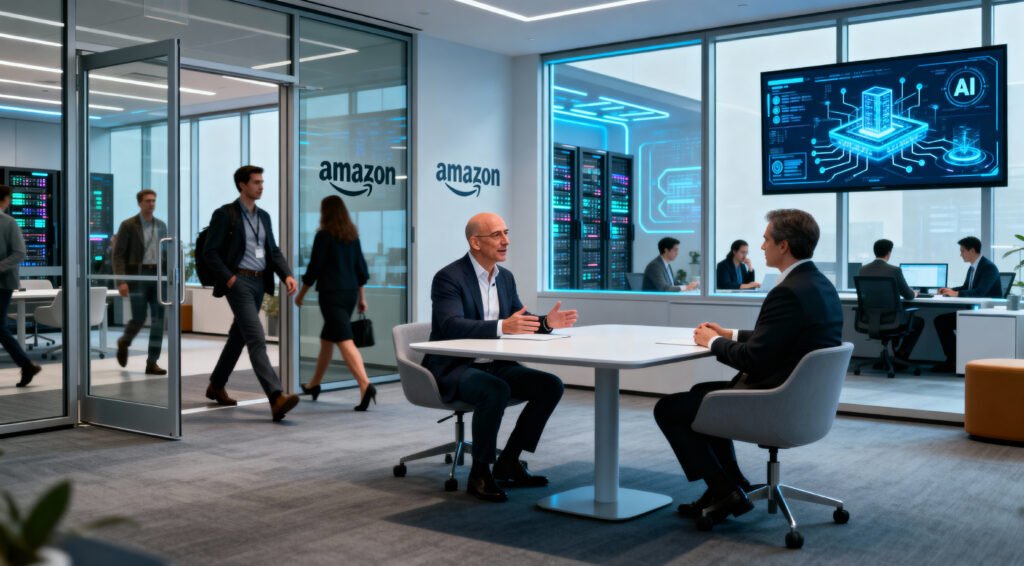Amazon Restructures Workforce to Power Its AI Future
Amazon said it will cut about 14,000 corporate jobs, which is about 4% of its workforce. Executives said that the decision was part of a plan to get ready for expanding AI activities, not just a normal reduction.
Beth Galetti, the Senior Vice President, said that the restructure makes the company more flexible by getting rid of layers that slow down its ability to respond to changes in technology. She said this was necessary to keep up with AI’s fast-paced innovation cycles and make the company’s competitive edge even stronger.

Strategic Realignment Prioritizes Efficiency and Ownership
Beth Galetti said again that smaller structures are necessary for AI transformation to make global market leadership possible. They help with speed, creativity, and accountability. She emphasized that teams need to take full responsibility for their results so they can swiftly adjust and stay effective in the face of continual changes in new technologies.
Leaders at Amazon said that the adjustments are meant to shift investment into projects that would benefit customers and help the company create value in the future. This alignment shows that the company has made a conscious effort to change its culture to focus on quantifiable results and strict resource management at all levels of the business.
Andy Jassy Promotes Startup Culture Around the World
Andy Jassy, the CEO, wants to bring back the flexibility of a startup to Amazon’s huge structure by modernizing its culture and flattening its management processes. His philosophy of leadership encourages innovation and accountability as key parts of a worldwide company strategy based on AI.
He says that keeping things simple is the key to staying productive while Amazon grows in cloud computing, shipping, and artificial intelligence infrastructure. Jassy thinks that by cutting down on red tape, teams will be able to come up with new ideas more quickly while still following Amazon’s Day One policy of strict execution.
Recommended Article: Korea Secures 260,000 Nvidia Blackwell Chips for AI Expansion
Expanding AI Infrastructure With Multi-Billion Dollar Investment
Amazon aims to spend around $118 billion this fiscal year on capital projects that will help expand AI infrastructure. The money will go toward new data centers and powerful computing clusters that will let Anthropic and other innovative AI developers across the world work together.
These projects show that Amazon wants to be the leader in AI-powered cloud services, logistics optimization, and retail automation over the next ten years. Analysts say that the company’s long-term capital investment plan will change the game and help it stay in the lead by continuing to modernize its infrastructure.
Shifting Workforce Dynamics Through AI Integration
Andy Jassy said that when AI takes over monotonous tasks, the makeup of the workforce needs to change to include more technical tasks that are worth more. He said that there would be a lot more new jobs in operational divisions relating to AI oversight, algorithm creation, and data engineering.
To make this change happen, personnel need to be retrained so they may move from administrative work to technical or strategic responsibilities that focus on innovation. The change fits with Amazon’s belief that companies should always be looking for ways to improve by learning, being flexible, and adopting new technologies before they become necessary.
From Hybrid Work to Full In-Office Collaboration
Amazon got rid of its hybrid work philosophy that stressed working together in the office to speed up decision-making and boost creative synergy between teams. Leadership decided that co-location is better for creativity and accountability than the scattered management structures that were common during the epidemic.
Andy Jassy said that meeting in person speeds up the iteration cycles needed to reach AI deployment goals and strategic goals quickly and effectively. The shift in policy shows that Amazon believes that the long-term benefits of a culture-driven speed advantage outweigh the short-term problems that come with adjusting the workforce.
Leadership Speed and Cultural Transformation Make Growth Happen
Andy Jassy’s letter to shareholders in 2024 said that speed was a conscious choice made by management that needed to be supported by changes to the company’s structure, culture, and procedures. He said that every level of management has to put flexibility, urgency, and modular design at the top of their list of priorities in order to keep Amazon’s competitive innovation going throughout the world.
The letter reaffirmed Amazon’s long-standing Day One philosophy, which places curiosity, ownership, and scrappiness at the heart of its culture and operations. This notion is now at the heart of Amazon’s larger plan to integrate AI into its business, which includes both changes to people and technology.
AI Transformation Reflects Broader Industry Realignment Trend
Experts in the field see Amazon’s job cuts as part of a worldwide trend that puts more emphasis on the efficiency of automation in digital businesses. Ben Barringer, an analyst, said that other big IT companies are also going through similar restructurings as investments in AI-driven process optimization rise throughout the world.
For Amazon, this plan is a way to be proactive and adapt to the future by cutting costs, reallocating cash, and coming up with new ideas faster to stay ahead of the competition. The company’s planned change under Jassy shows how big businesses change their structures to make the most of AI’s exponential potential in a way that lasts.























